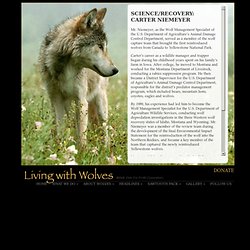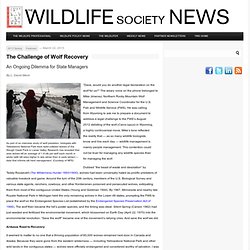

Smile! You’re at the best WordPress.com site ever. Living With Wolves - About Us - Carter Niemeyer. Mr.

Niemeyer, as the Wolf Management Specialist of the U.S. Department of Agriculture’s Animal Damage Control Department, served as a member of the wolf capture team that brought the first reintroduced wolves from Canada to Yellowstone National Park. Carter’s career as a wildlife manager and trapper began during his childhood years spent on his family’s farm in Iowa. After college, he moved to Montana and worked for the Montana Department of Livestock, conducting a rabies suppression program.
He then became a District Supervisor for the U.S. By 1989, his experience had led him to become the Wolf Management Specialist for the U.S. Moving to Idaho, Carter served as the Wolf Recovery Coordinator of the U. Maggie Dwire, SSP Program Biologist, U.S. Fish and Wildlife Service. Dwire said Ernesta and the two male wolves are being kept in a large fenced-in area that mimics the high desert landscape that surrounds it.

There are about a dozen wolves at Sevilleta. "The goal for is to accept one of the males as mate," Dwire said. "If gets pregnant, may be released with mate in spring, but we might also decide to wait until late summer. There are a lot of factors that must be taken into account. " Searching for Gordon Haber… And the wolves he loved - A writer’s journey to know an enigmatic activist who died in late 2009 - Anchorage Press: News.
October 14.

My thoughts drift north toward Denali National Park. Can a year already have passed since researcher and activist Gordon Haber died in a plane crash, while tracking the wolves he so deeply loved? The passage of time can be a tricky thing. One moment it seems that Haber died only yesterday; the next it seems a lifetime ago. Perhaps for me his death has both immediacy and distance because I’ve spent much of the past year digging into Haber’s life and work, moving back and forth through his decades at Denali. Though I knew Gordon for more than 20 years, I never knew him well.
Sometimes we’d say “hello,” other times not. I always hoped I might someday join Gordon “in the field,” together watching the wolves he loved so much. My sense of Gordon and the reach of his work expanded greatly in the days after his death, especially while listening to friends and colleagues share stories at a memorial service. Jay Mallonee. Jay Mallonee is a research biologist with a master's degree in neurobiology/animal behavior.

Through his business of Wolf and Wildlife Studies, he conducted a ten year study of the Fishtrap pack in northwest Montana: the longest behavioral study of wolves in Montana's history outside of Yellowstone National Park. Previous studies have included wolves in captivity and a variety of cetaceans such as gray whales, bottlenose dolphins, harbor porpoise, Dall's porpoise, and orcas. He also taught college level science courses for 15 years with an emphasis in environmental science and anatomy/physiology. Other courses included chemistry, ecology, biology, physical science, physiological psychology, developmental psychology, and wolf biology at Michigan Tech University. L. David Mech. Lucyan David "Dave" Mech (born January 18, 1937) is an internationally recognized wolf expert, a senior research scientist for the U.S.

Department of the Interior's U.S. Geological Survey (since 1970), and an adjunct professor at the University of Minnesota in St. Paul. He has researched wolves since 1958 in places such as Minnesota, Canada, Italy, Alaska, Yellowstone National Park, and on Isle Royale. Mech is the founder of the International Wolf Center and sits on its Board of Directors as Vice Chair. He has published ten books and numerous articles about wolves and other wildlife, the most famous of these being his books The Wolf: The Ecology and Behavior of an Endangered Species (1970, University of Minnesota Press) and Wolves: Behavior, Ecology, and Conservation which he co-edited with Luigi Boitani (2003, University of Chicago Press).
Research[edit] Education[edit] External links[edit] Mech Delisting Testimony. David Mech a trapper who kills wolves? December 16, 2010 I’m shocked and saddened by the article supporting wolf hunting, that appeared in the International Wolf Center (IWC) Winter 2o1o edition.

Unbelievably, the author of the article was Dr. Mech, the renowned wildlife biologist, who founded the IWC and is vice-chair of their Board of Directors. Not only does Dr. Mech support wolf hunts but he goes into shocking detail on how to carry them out. Last year, Doug Smith, the Yellowstone wolf biologist, stated wolves should be hunted later in winter when their pelts are thicker. Why would the IWC publish this when wolf advocates are fighting so hard to save wolves from another Western extermination? Considerations for Developing Wolf Harvesting Regulations in the Contiguous United States L. Other equally upsetting articles that appeared in the same IWC issue: The Challenge of Wolf Recovery. By L.

David Mech As part of an intensive study of wolf predation, biologists with Yellowstone National Park track radio-collared wolves of the Slough Creek Pack in Lamar Valley. Research has revealed that area wolves kill an average of 1.8 elk per wolf each month in winter (with kill rates higher in late winter than in early winter) — data that informs elk herd management. (Courtesy of NPS) “Dave, would you do another legal declaration on the wolf for us?”
Dubbed “the beast of waste and desolation” by Teddy Roosevelt (The Wilderness Hunter 1893/1900), wolves had been universally hated as prolific predators of valuable livestock and game. Arduous Road to Recovery It seemed to matter to no one that a thriving population of 60,000 wolves remained next door in Canada and Alaska: Because they were gone from the western wilderness — including Yellowstone National Park and other wild lands in the contiguous states — wolves were officially endangered and considered worthy of salvation.